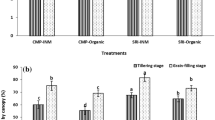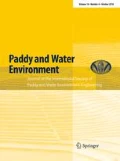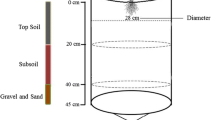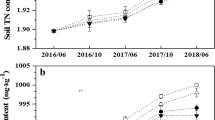Abstract
A field experiment was conducted in 2005 to investigate the effects of modified rice cultivation methods on: water use efficiency, the uptake of nutrients (N, P and K) by plants, and their distribution within plants and their internal use efficiency. The treatments were modified methods of irrigation, transplanting, weeding, and nutrient management, comparing the System of Rice Intensification (SRI) with standard rice-growing methods including traditional flooding (TF). Results showed that the uptake of N, P, and K by rice plants during their growth stages was greater with SRI management compared to TF, except during the tillering stage. At maturity stage, SRI plants had taken up more nutrients in their different major organs (leaves, stems, and sheaths; panicle axis; and seeds), and they translocated greater amount of nutrients to the grain. Under SRI, the ratio of N, P, and K in seed grain to total plant N, P, and K was 4.97, 2.00, and 3.01% higher, respectively, than with TF. Moreover, under SRI management, internal use efficiency of the three macronutrients (N, P, and K) was increased by 21.89, 19.34, and 16.96%, respectively, compared to rice plants under TF management. These measurements calibrate the crop’s physiological response to differences in cultural practices, including the maintenance of aerobic versus anaerobic environment in the root zones. With SRI, irrigation water applications were reduced by 25.6% compared to TF. Also, total water use efficiency and irrigation water use efficiency was increased with SRI by 54.2 and 90.0%, respectively. Thus, SRI offered significantly greater water saving while at the same time producing more grain yield, in these trials 11.5% more compared to TF.







Similar content being viewed by others

References
Bhuiyan SL (1992) Water management in relation to crop production: case study on rice. Outlook Agric 21:293–299
Bonkowski M (2004) Protozoa and plant growth: the microbial loop in soil revisited. New Phytol 162:616–631
Bouman BAM, Tuong TP (2001) Field water management to save water and increase its productivity in irrigated rice. Agric Water Manag 49:11–30
Chen HZ, Zhu DF, Rao LB, Lin XQ, Zhang YP (2006) Effects of SRI technique on population quality after heading stage and yield formation in rice, in Chinese with English summary. J Huazhong Agric Univ 25:483–487 in Chinese
FAO (2001) FAO statistical databases. Food and agriculture organization of the United Nations, Rome
Guerra LC, Bhuiyan SI, Tuong TP, Barker R (1998) Producing more rice with less water from irrigated systems. SWIM paper 5. IWMI/IRRI, Colombo
Iswandi I, Rupela OP, Thiyagarajan TM, Uphoff N (2011) A review of studies on SRI effects on beneficial organisms in rice soil rhizospheres. Paddy Water Environ (forthcoming)
Kato Y, Okami M, Katsura K (2009) Yield potential and water use efficiency of aerobic rice (Oryza sativa L.) in Japan. Field Crops Res 113:328–334
Kronzucker HJ, Siddiqui MY, Glass ADM, Kirk GJD (1999) Nitrate-ammonium synergism in rice: a subcellular flux analysis. Plant Physiol 119:1041–1045
Krouk G, Lacombe B, Bielach A, Perrine-Walker F, Malinska K, Mounier E, Hoyerova K, Tillard P, Ljung K, Zazimalova E, Benkova E, Nacry P, Gojon A (2010) Nitrate-regulated auxin transport by NRT1.1 defines a mechanism for nutrient-sensing in plants. Dev Cell 18:927–937
Li GH, Xue LH, Gu W, Yang CD, Wang SH, Ling QH, Qin X, Ding HF (2009) Comparison of yield components and plant type characteristics of high-yield rice between Taoyuan, a ‘special eco-site’ and Nanjing, China. Field Crops Res 112:214–221
Liang YM, Lin XQ, Sun YF, Zhu DF, Shi GA (2004) Study on yield and its components of Xieyou 9308 under the system of rice intensification. Chin Agric Sci Bull 20:84–86 in Chinese
Lin XQ, Zhou WJ, Zhu DF (2005) The photosynthetic rate and water use efficiency of leaves at different position at panicle initiation stage under the System of Rice Intensification (SRI). Chin J Rice Sci 19:200–206 in Chinese
Lin XQ, Zhou WJ, Zhu DF, Chen HZ, Zhang YP (2006) Nitrogen accumulation remobilization and partitioning in rice (Oryza sativa L.) under an improved irrigation practice. Field Crops Res 96:448–454
Long X, Ma J, Xu FY, Wang HZ, Huang QL, Yuan ZX (2005) Study on the seedling-age and planting density in SRI. J Sichuan Agric Univ 23:365–373 in Chinese
Maclean JL, Dawe DC, Hardy B, Hettel GP (2002) Rice Almanac, 3rd edn. International Rice Research Institute, Los Baños
Mishra A, Salokhe VM (2008) Seedling charactistics and the early growth of transplanted rice under different water regimes. Exp Agric 44:1–19
Nguyen NV, Ferrero A (2006) Meeting the challenges of global rice production. Paddy Water Environ 4:1–9
Olaleye AO, Tabi FO, Ogunkunle AO, Sahrawat KL (2001) Effect of toxic iron concentrations on the growth of lowland rice. J Plant Nutr 24:441–457
Peng SB, Buresh RJ, Huang JL, Yang JC, Zou YB, Zhong XH, Wang GH, Zhang FS (2006) Strategies for overcoming low agronomic nitrogen use efficiency in irrigated rice systems in China. Field Crops Res 96:37–47
Prasertsak A, Fukai S (1997) Nitrogen availability and water stress interaction on rice growth. Field Crops Res 52:249–260
Rupela OP, Wani SP, Kranthi M, Humayun P, Satyanarayana A, Goud V, Gujja B, Punnarao P, Shashibhushan V, Raju DJ, Reddy PL (2006) Comparing soil properties of farmers’ fields growing rice by SRI and conventional methods. In: 1st National SRI Symposium, Worldwide Fund for Nature-ICRISAT, Patancheru, Hyderabad, 17–18 November 2006
Sahrawat KL (2000) Elemental composition of the rice plant as affected by iron toxicity under field conditions. Commun Soil Sci Plant Anal 132:2819–2827
Satyanarayana A (2005) System of rice intensification—an innovative method to produce more with less water and inputs. In: 4th IWMI-Tata Annual Partner’s Meeting. Institute for Rural Management, Anand
Si T (2000) Suggestion and discussion of several problems on water saving rice production in China, in Chinese. Irrig Drain 19:30–33
Stoop WA, Uphoff N, Kassam A (2002) A review of agricultural research issues raised by the system of rice intensification (SRI) from Madagascar: opportunities for improving farm systems for resource-poor farmers. Agric Syst 71:249–274
Tang QY, Feng MG (2002) Practical application of statistics analysis and data processing system. Science Press, Beijing
Tao SS, Ma J (2003) Improvement of the system of rice intensification (SRI) and its application in medium hybrid rice of the double cropping system. Hybrid Rice 18:47–48 in Chinese
Tuong TP, Bouman BAM (2003) Rice production in water-scarce environments. In: Kijne JW, Barker R, Molden D (eds) Water productivity in agriculture: limits, opportunities for improvement. CABI Publishing, Wallingford, pp 53–67
Uphoff N, Fernandes ECM, Yuan LP, Peng JM, Rafaralahy S, Rabenandrasana J (eds) (2002) Assessment of the system of rice intensification (SRI). In: proceedings of the international conference, Sanya, China, 1–4 April 2002. Cornell international institute for food, agriculture and development, Ithaca (http://ciifad.cornell.edu./sri/proccontents.html)
Wang SH, Cao WX, Jiang D, Tai DB, Zhu Y (2003) Effects of SRI technique on physiological characteristics and population development in rice. Chin J Rice Sci 17:31–36 in Chinese
Xu FY, Ma J, Wang HZ, Liu HY, Huang QL, Ma WB, Ming DF (2003) The characteristics of roots and their relation to the formation of grain yield under the cultivation by system of rice intensification (SRI). Hybrid Rice 18:61–65 in Chinese
Yang CM, Yang LZ, Yang YX, Ouyang Z (2004) Rice root growth and nutrient uptake as influenced by organic manure in continuously and alternately flooded paddy soils. Agric Water Manag 70:67–81
Yang C, Yang L, Ouyang Z (2005) Organic carbon and fraction in paddy soil as affected by different nutrient and water regimes. Geoderma 124:133–142
Yu HM, Zhu FQ, Wang CL (2003) A preliminary report of the application of the high-yielding techniques of SRI in single cropping hybrid rice. Hybrid Rice 19:33–35 in Chinese
Yu AY, Wu ZQ, Lin XQ, Zhu GP, Zhou NT, Chen DL, Shen YM (2005) Optimization of high-yield cultural practice under the system of rice intensification. Chin Agric Sci Bull 21:162–164 in Chinese
Yuan LP (2001) The system of rice intensification. Hybrid Rice 16:1–3 in Chinese
Zhao LM, Wu LH, Li YS, Lu XH, Zhu DF, Uphoff N (2009) Influence of the system of rice intensification on rice yield and nitrogen and water use efficiency with different N application rates. Exp Agric 45:275–286
Zhao LM, Wu LH, Li YS, Sarkar A, Zhu DF, Uphoff N (2010) Comparisons of yield, water use efficiency, and soil microbial biomass as affected by the System of Rice Intensification. Commun Soil Sci Plant Anal 41:1–12
Zhong HM, Huang AM, Liu JP, Li JN, Wu FB, Ouyang FP (2003) Analysis on the yield-increasing effects and economic benefits of the system of rice intensification (SRI) in hybrid rice. Hybrid Rice 18:45–46 in Chinese
Zhu DF et al (2006) The theory and practice of SRI. Agricultural Science and Technology Press, Beijing In Chinese
Acknowledgments
This research was supported by the Key Project of Agricultural Construction Adjustment of Ministry of Agriculture of China (no. 2003-01-02A), the National Critical Project for Science and Technology on Water Pollution Prevention and Control of China (no. 2008-ZX-07101-006) and the Special Fund for Agro-scientific Research in the Public Interest of China (201003016) and the National Natural Science Foundation of China (No. 30871595).
Author information
Authors and Affiliations
Corresponding author
Rights and permissions
About this article
Cite this article
Zhao, L., Wu, L., Wu, M. et al. Nutrient uptake and water use efficiency as affected by modified rice cultivation methods with reduced irrigation. Paddy Water Environ 9, 25–32 (2011). https://doi.org/10.1007/s10333-011-0257-3
Received:
Revised:
Accepted:
Published:
Issue Date:
DOI: https://doi.org/10.1007/s10333-011-0257-3



